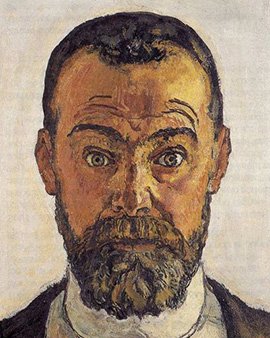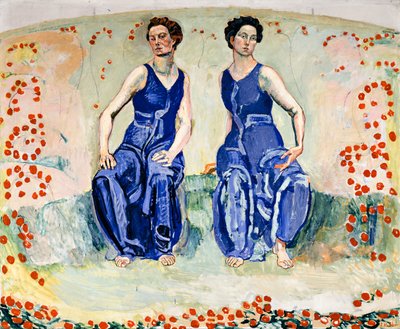Mirror-image constructed lake landscapes, self-portraits as reflections on the essence of the self and nature: these are the central motifs that preoccupied the Swiss painter Ferdinand Hodler (1853-1918) throughout his life.
In the early phase of the film, as early as 1896, Hodler did not miss the opportunity to stage himself in the hustle and bustle of hat-waving visitors and artist colleagues at the opening ceremony of the Geneva National Exhibition. The facial features and stature of the slender man with beard, dressed in suit and melon, correspond to those he himself drew of himself in his self-portraits. The contours of his eyes and ears have the same shape as in contemporary photographs. The scene immortalized on celluloid, which Hodler's moving image transmits, was documented by the artist himself in his notes. It was taken around the time when the Thun-born painter's high-altitude flight was approaching an abrupt decline.
At first the young Hodler, who had grown up in poor circumstances, had been encouraged as an extraordinary, promising talent. He received the undivided support of the academies and art critics, and was offered teaching positions and solo exhibitions. With his panoramic landscape paintings, he quickly achieved prosperity in the Geneva art scene. Hodler travelled throughout Europe and soon became the most renowned painter in Switzerland. Even today his paintings still fetch record prices: In 2007, Lake Geneva from Saint-Prex achieved an auction result of over 10 million euros, making it the most expensive painting in Switzerland.
With the outbreak of the Second World War the tide finally turned. Hodler's criticism of the Germans' aggressive actions, especially their bombing of Reims Cathedral, made him a target of attacks by the German press. The Munich Secession did not miss the opportunity to defame the artist in public. While the circle around the Blauer Reiter, including Alexej von Jawlensky, Franz Marc, Paul Klee and Wassily Kandinsky, organized joint exhibitions of German, Dutch, Russian and French artists, the accredited Munich artistic elite fell into nationalist propaganda, describing Hodler's statement as an "expression of spiteful sentiment":"Anyone who lives in Switzerland, who has a German-sounding name and does not want to understand what is at stake in this war, and does not know how much our Germany means for the morality of Europe, indeed, that the safeguarding of the highest cultural goods depends on our victory, lacks the inner education that makes the great artist in the first place.“ Hodler's exclusion from the most important artists' associations was the immediate consequence. The painting Auszug der deutschen Studenten in den Freiheitskrieg von 1813, a jewel of the Friedrich Schiller University in Jena, had to be taken down and sold. Hodler's international career was thus ended. Only his Swiss compatriots preserved the memory of the Symbolist, to whom exhibitions in the world's most famous museums are dedicated today.
×





.jpg)
.jpg)
.jpg)
.jpg)
.jpg)
.jpg)
.jpg)
.jpg)
.jpg)
.jpg)
.jpg)
.jpg)
.jpg)
.jpg)
.jpg)
.jpg)
.jpg)
.jpg)
.jpg)
.jpg)
.jpg)
.jpg)
.jpg)
.jpg)
.jpg)
.jpg)
.jpg)
.jpg)
.jpg)
.jpg)
.jpg)
.jpg)
.jpg)
.jpg)
.jpg)
.jpg)
.jpg)
.jpg)
.jpg)
.jpg)
.jpg)
.jpg)
.jpg)
.jpg)
.jpg)
.jpg)
.jpg)
.jpg)
.jpg)
.jpg)
.jpg)
.jpg)
.jpg)
.jpg)
.jpg)
.jpg)
.jpg)
.jpg)
.jpg)
.jpg)
.jpg)
.jpg)
.jpg)
.jpg)
_(Suisse)_(Etang_Long_Crans_Montana)_Peintu_-_(MeisterDrucke-1313577).jpg)
_(Suisse)_(Etang_Long_Crans_Montana)_Peintu_-_(MeisterDrucke-1313577).jpg)
.jpg)
.jpg)
_Second_version_by_Hodler_Ferdinand_(1853-1918)_Oil_on_canva_-_(MeisterDrucke-1313042).jpg)
_Second_version_by_Hodler_Ferdinand_(1853-1918)_Oil_on_canva_-_(MeisterDrucke-1313042).jpg)
.jpg)
.jpg)
.jpg)
.jpg)
.jpg)
.jpg)
.jpg)
.jpg)
.jpg)
.jpg)
.jpg)
.jpg)


.jpg)
.jpg)
.jpg)
.jpg)
.jpg)
.jpg)
.jpg)
.jpg)
.jpg)
.jpg)
.jpg)
.jpg)
.jpg)
.jpg)
.jpg)
.jpg)
.jpg)
.jpg)
.jpg)
.jpg)
.jpg)
.jpg)
.jpg)
.jpg)
.jpg)
.jpg)
.jpg)
.jpg)
.jpg)
.jpg)
.jpg)
.jpg)
.jpg)
.jpg)
.jpg)
.jpg)
.jpg)
.jpg)
.jpg)
.jpg)
.jpg)
.jpg)
.jpg)
.jpg)
.jpg)
.jpg)
.jpg)
.jpg)
.jpg)
.jpg)
.jpg)
.jpg)
.jpg)
.jpg)
.jpg)
.jpg)
.jpg)
.jpg)
.jpg)
.jpg)
.jpg)
.jpg)
.jpg)
.jpg)
.jpg)
.jpg)
.jpg)
.jpg)
.jpg)
.jpg)
.jpg)
.jpg)
.jpg)
.jpg)
.jpg)
.jpg)
.jpg)
.jpg)
.jpg)
.jpg)
.jpg)
.jpg)
.jpg)
.jpg)
.jpg)
.jpg)
.jpg)
.jpg)
.jpg)
.jpg)
.jpg)
.jpg)
.jpg)
.jpg)
.jpg)
.jpg)
.jpg)
.jpg)
.jpg)
.jpg)
.jpg)
.jpg)
.jpg)
.jpg)
.jpg)
.jpg)
.jpg)
.jpg)
.jpg)
.jpg)
_-_(MeisterDrucke-1659525).jpg)
_-_(MeisterDrucke-1659525).jpg)
.jpg)
.jpg)
.jpg)
.jpg)






